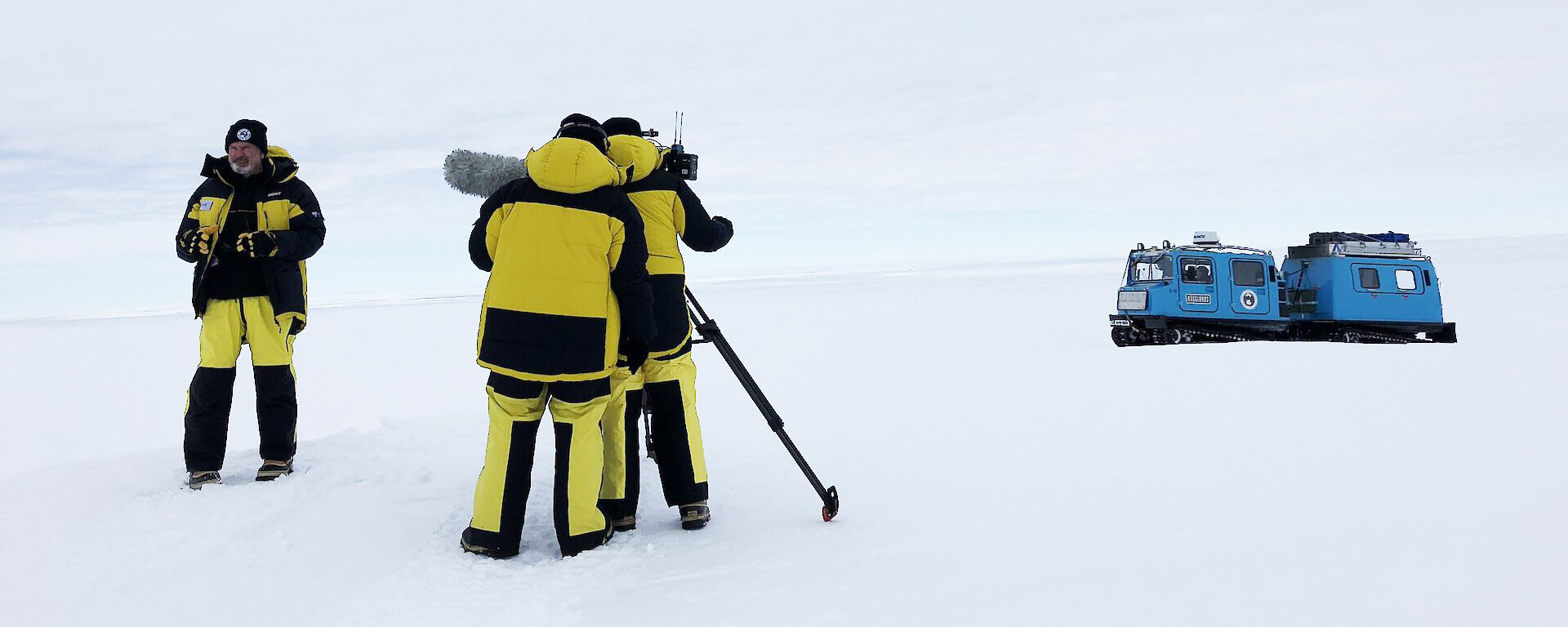Antarctic video gallery
Rebecca Jeffcoat Station Leader
Video transcript
I just had such an extraordinary year at Casey, I fell in love with the place. I've been a little bit homesick in the three years since I was there. I'm really looking forward to experiencing the environment again but slightly different, at a different station.
I love the wildlife and the weather. Living through blizzards is incredible and I just love the community and experiencing that with, a sort of, like-minded group of expeditioners.
Mawson's always been on my bucket list. It's the station that has the, sort of, historical context. A beautiful environment, has the mountain ranges behind the station and the ice plateau.
And then get lots of opportunity to travel on the sea ice, and then that big bucket list item of visiting the emperor penguin colonies, and getting to do, sort of, scientific monitoring of those colonies, which would be amazing.
I am down on station for a year. We go in in February and then come out again the following February. And I will have 15 expeditioners, well there'll be 15 of us counting me. Some of the skills I have that set me up well for work in Antarctica? I've been in the Navy for over 30 years. Probably 10 to 15 years of that in leadership positions, and in particular I was the Commanding Officer of Garden Island in Sydney. So I had potentially about 5,000 people working on that base and I was responsible for them. So the job's very similar in Antarctica, just a lot less people, but a lot more isolated.
I think the things that make a good Antarctic team are that sense of community. We all get in and work together towards that, sort of, ultimate objective of, you know, getting through the season, getting all of your operational plans done for the year. You need to be resilient and adaptable because things will always change down there and resilience is important because we are isolated.
We're stuck down there for, you know, at least eight months before anyone can come and get us, so we need to be quite resilient, and just be enthusiastic and love the place and, sort of, want to be there, to experience it.
So they're the qualities that make a good team. If there's anything I would do differently? I think I had such an extraordinary experience last time I probably wouldn't change too much. I think I would, now that I know what it's like, and what the role is like, I'll be much more efficient. And I will potentially sing a little bit less karaoke!
[end transcript]
Ship of Firsts
Video transcript
Ship of Firsts
Lloyd Symons, Voyage Leader
So this voyage is a really critical first step in setting up the next 30 years of the RSV Nuyina. We have been delivered an immensely capable ship and now we have to learn how to use it, learn how to operate it in this environment, and that's the challenge that's before us. But I think on this voyage we're making a really solid start.
But one of the significant things about RSV Nuyina is that she's an icebreaker and that allows us to get into areas that no other ship can can do. So it's really important for Australia to have a capability to get scientists into the ice lane, so that we can uncover the secrets of this region.
Dave Buller, Casey Station Leader
I would say that that particular fuel is the lifeblood of the station. You think about everything that we do to power the station. So you think about what keeps you warm, what feeds you, the lighting, what heats the water when you have a shower. There's, you know, the diesel runs everything.
Kasey Williams, Environmental Scientist
So far we're going really well, the weather's playing ball with us today, the winds are low, the ships are working well as it should. The lines are going well and the refueling is going to schedule, which is awesome.
Technician
We'll head to 2,600 metres.
Floyd Howard, Senior Acoustician
The multi-beam uses sound to map the seabed. So it sends out a fan of sound underneath the ship, and then we measure how long it takes for that sound to bounce off the sea floor, to give us an image of the shape of the seabed.
Rob King, Krill Biologist
We switched on the filter table and very quickly an Antarctic krill came out, shortly followed thereafter by an absolute swarm of krill, which just launched down into our collection table, and we, in a matter of five minutes, had about 400 krill swimming in buckets next to us. Absolutely amazing
Anton Rocconi, Aquarist
A lot of these animals will come all the way back to AAD head office in Kingston. We've got an aquarium facility out the back there, where we're making space for these animals as we speak. And they'll be divided up into appropriate tanks ready, hopefully ready, for students and researchers to come and work with them.
Michael Santarossa, Technical Services Manager
So a moon pool, which is essentially a hole in the middle of the ship, allows us to lower scientific equipment through the vessel instead of out the side. And this is really important on an icebreaker, where a lot of the time we're completely surrounded by ice.It was largely successful. We tested our nerve, we got down there, all the systems worked.
Will Rigby, Mechatronics Design Engineer
NUTTS is Nuyina Underwater Towed Termination System.
It lets us send one kilowatt of power down to underwater systems, and we can use the front optic lines in the tow cable to get way more data up the cable than what was possible in the past.
Johnathan Kool, Data Manager
So the data is collected from a really wide range of sensors. So we have meteorological instruments, seabed mapping sensors. We have oceanographic instruments, so we have these broad range of sensors that all feed into collecting data aboard the ship.
Gerry O’Doherty, Master RSV Nuyina, Serco
Well this is an opportunity to actually test out the tasks that the ship was designed to do, and actually I've been surprised at how easy some of the tasks have been.
There's been a lot of preparation and a lot of planning go into them, and there's been practice at various tasks, doing this and that, but this is the first time that we've done all of those things together in concert.
Lloyd Symons, Voyage Leader
The ship is equipped with a large array of very advanced and complicated scientific systems and it will take us many years to get to grips with those systems, but I think we've made a very solid start on this voyage.
[end transcript]
Dave Buller station leader
Video transcript
I was previously a station leader in Casey in 2011. It does get under your skin it's an amazing and dynamic working environment down there with so many challenges.
My background is predominantly defence. 30-plus years in army. In actual fact when i went down to Casey in 2011 I was seconded by army to work with the aid in a non-military capacity and I guess you know as part of that that's where the love of Antarctica came into fruition.
Post leaving the defence in 2019 I decided to start up my own photography business which has been bad timing with COVID that didn't quite work out as well as what I would have liked and I think what I've missed the most is working with people from such diverse backgrounds professions and or age groups and seeing those people come together to work on common and unified goals.
Going to be an exceptionally busy summer but that's you know that's why we're here really really keen to value add and to make a difference and and part of that is I think you get to see the excitement from the expeditioners as you're preparing for this as well they know they're going to be part of something quite special.
The million year ice core coupled with the deep traverse project coupled with the deep field camp that we're hoping to establish, just getting that into station is a huge logistical challenge probably far surpassed by anything that the AAD has attempted before.
It's an amazing place it's the wild frontier unpredictable you know they call it the A-factor but it is really an amazing place.
[end transcript]


